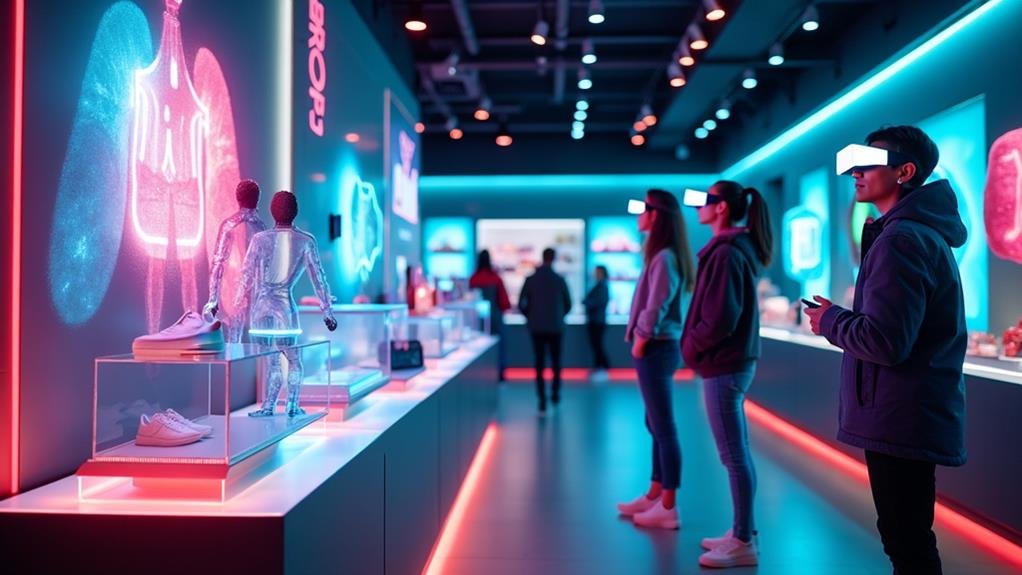We’re witnessing a seismic shift in business sales and marketing, with innovative trends reshaping how companies connect with customers and drive growth. AI-powered marketing automation and predictive analytics are revolutionizing efficiency and strategy. Hyper-personalized experiences and video-first content strategies are enchanting audiences like never before. Social commerce integration and voice search optimization are transforming the customer journey. Data privacy-centric approaches and evolving influencer collaborations are building trust and authenticity. Sustainability-driven brand positioning is becoming a competitive necessity. These trends aren’t just changing the game; they’re redefining it entirely. Exploring each in depth reveals the future of business success.

We’re witnessing a revolution in marketing automation, driven by the power of AI. As we explore 2024, it’s clear that AI has become an indispensable ally for marketers, with 73% regularly harnessing its potential for various tasks. This shift isn’t just about keeping up with trends; it’s about revealing unprecedented efficiency and effectiveness in our marketing efforts.
The numbers speak volumes: 75% of marketers report improved efficiency thanks to AI-driven automation. We’re no longer bogged down by routine tasks, freeing us to focus on strategic initiatives that drive real growth.
But that’s just the tip of the iceberg. Predictive analytics, a cornerstone of AI marketing automation, is reshaping how we optimize campaigns. By analyzing consumer behavior and forecasting trends, we’re able to stay ahead of the curve, delivering personalized experiences that resonate with our audience.
As we look towards 2025, the future of marketing automation is even brighter. Automated A/B testing and AI influencers are set to refine our strategies further, offering enhanced personalization and engagement.
It’s a brave new world of marketing, and AI is our compass.

Building on the AI-powered revolution in marketing automation, hyper-personalized customer experiences have become the gold standard for engaging and retaining consumers in 2024.
We’re seeing a seismic shift in how businesses approach customer interactions, with AI and machine learning at the forefront of this transformation. The numbers don’t lie: 80% of consumers crave personalized shopping experiences, and companies that deliver are reaping the rewards with a staggering 200% ROI on average.
But it’s not just about boosting sales; it’s about fostering loyalty. When we offer tailored content and product recommendations, we’re showing customers we recognize their unique needs. This approach isn’t just effective—it’s expected. A whopping 90% of shoppers are willing to share their data for better experiences.
However, we must tread carefully. Transparency is key. Customers are more likely to engage with brands that respect their privacy and seek explicit consent for personalization efforts.
As we navigate this new landscape, we’re not just selling products; we’re crafting experiences that resonate on a personal level, turning casual browsers into loyal brand advocates.

A tidal wave of video content is reshaping the digital marketing landscape in 2024. We’re witnessing a seismic shift towards short-form videos on platforms like TikTok and Instagram Reels, with two-thirds of marketers planning to boost their investment in this arena. It’s clear why: video content isn’t just a trend, it’s a necessity for staying competitive.
We can’t ignore the numbers. A staggering 91% of businesses are now using video as a marketing tool, and it’s no wonder. Video enhances retention rates and engagement levels like nothing else.
But it’s not just about creating content; it’s about crafting stories that resonate. Interactive videos, tutorials, and live streaming sessions are proving to be game-changers in audience engagement.
Let’s not forget the power of user-generated content. It’s the golden ticket to authenticity and reach, building trust and connection with consumers.
With over 500 hours of content uploaded to YouTube every minute, the opportunity to capture audience attention is vast. We must embrace video-first strategies to stay ahead in this dynamic landscape.

Three key factors are driving the rapid integration of social commerce into business strategies: consumer preference, platform innovation, and the power of user-generated content.
We’re witnessing a seismic shift in how people shop, with over half of users now preferring to make purchases directly through social media channels. This trend isn’t just a passing fad; it’s reshaping the entire e-commerce landscape.
Major platforms like Instagram and Facebook aren’t sitting idle. They’re constantly enhancing their shopping features, creating seamless experiences that blend social interaction with buying power.
But here’s the kicker: user-generated content is the secret sauce. A staggering 93% of consumers trust UGC more than traditional ads, making it a goldmine for brands looking to build authenticity and drive sales.
Let’s talk numbers. By the end of 2024, brands are expected to pour $9.1 billion into Instagram ads alone.
With 200 million users visiting business profiles daily on the platform, it’s clear that social commerce isn’t just an option – it’s a necessity for businesses aiming to stay competitive and relevant in today’s digital marketplace.

As we navigate the ever-evolving digital landscape, voice search optimization has emerged as a vital frontier for businesses. With projections indicating that 55% of households will own smart speakers by 2025, we’re witnessing a seismic shift in how consumers interact with technology.
It’s time we adapt our SEO strategies to meet this new reality. To stay ahead of the curve, we must focus on long-tail keywords and conversational phrases that mirror natural speech patterns. This approach will greatly improve our content’s discoverability through voice searches.
Isn’t it fascinating how technology is pushing us to be more human in our digital interactions?
Let’s not forget the importance of structured data markup. It’s essential for ensuring voice search algorithms can accurately interpret and deliver relevant information based on user queries.
We’re also seeing a surge in local searches via voice commands, making local SEO optimization more important than ever.

From within the domain of digital innovation, Augmented Reality (AR) is revolutionizing marketing strategies.
We’re witnessing a seismic shift in consumer preferences, with 70% of shoppers now favoring AR-enhanced experiences. This isn’t just a passing fad; it’s reshaping how we interact with products and brands.
Consider Crate and Barrel’s approach: they’ve harnessed AR to let customers visualize furniture in their own homes. It’s not just cool; it’s driving real results.
We’re seeing higher engagement, increased satisfaction, and—crucially—better conversion rates. When consumers can interact virtually with products, they’re more likely to make that purchase.
But this is just the beginning.
We’re looking at a future where AR applications will span countless industries, transforming brand storytelling and deepening consumer connections.
It’s no wonder that 84% of marketers are planning to invest in AR/VR technologies by 2024.
The writing’s on the wall: immersive experiences are the future of marketing.
As we move forward, we’ll need to adapt our strategies to meet this growing demand for interactive, engaging content that blurs the line between digital and physical realities.

Privacy has become the linchpin of modern marketing strategies. We’re witnessing a seismic shift in consumer attitudes, with 80% expressing concerns over data privacy in marketing. This isn’t just a passing trend; it’s a fundamental change in the marketing landscape. As brands, we must adapt or risk losing consumer trust.
The numbers don’t lie: search volume for data privacy has doubled in the past five years. Consumers are more aware and more demanding when it comes to protecting their personal information. We can’t ignore that 42% of consumers feel uncomfortable with personalized ads. It’s clear we need to rethink our approach.
But here’s the good news: by prioritizing transparency and ethical data practices, we can turn this challenge into an opportunity. A whopping 87% of marketers are planning to invest in consumer data control initiatives.
Why? Because robust data privacy practices aren’t just about compliance; they’re a competitive advantage. By fostering trust and loyalty, we’re building stronger relationships with our customers.
In this new era, data privacy isn’t a roadblock—it’s the key to revealing true customer engagement and long-term success.

Influencer marketing has undergone a dramatic transformation in recent years. We’re witnessing a seismic shift in how brands engage with consumers through social media personalities. No longer content with celebrity endorsements, companies are now seeking authentic connections with their target audiences.
This evolution is reflected in the staggering projection that influencer marketing spending will reach $35 billion by 2024.
We’re seeing a pivot towards micro and nano-influencers, who offer niche relevance and genuine engagement. This strategy isn’t just a passing fad; it’s delivering results. Nearly half of marketers report better ROI from influencer campaigns compared to traditional channels.
The success of collaborations like Dunkin’s partnership with Charli D’Amelio underscores the tangible benefits of these alliances.
As we look to the future, it’s clear that influencer marketing isn’t slowing down. A whopping 84% of marketers plan to increase their investment in this arena.
We’re entering an era where authenticity reigns supreme, and brands that can harness the power of genuine influencer relationships will lead the pack in consumer engagement and sales growth.

In today’s marketplace, sustainability has become a powerful differentiator for brands seeking to capture consumer attention and loyalty.
We’re witnessing a significant shift in consumer preferences, with two-thirds of buyers now favoring brands that demonstrate genuine sustainability efforts. This trend isn’t just a passing fad; it’s reshaping the very foundation of brand positioning and marketing strategies.
To succeed in this new landscape, we must recognize that authenticity is key. Consumers are savvy and can spot greenwashing from a mile away.
Brands that truly embody sustainable practices are reaping the rewards of increased customer loyalty and trust. By aligning our marketing campaigns with eco-friendly values, we’re not only meeting consumer demands but also gaining a competitive edge.
Let’s face it: sustainability-driven brand positioning is no longer optional. It’s a critical component of business success.

As we explore the domain of predictive analytics for sales, it’s clear that this powerful tool is revolutionizing how businesses approach their sales strategies.
We’re witnessing a significant shift, with 63% of organizations now harnessing predictive analytics to enhance their sales forecasting accuracy. This isn’t just a passing trend; it’s a game-changer that’s reshaping the sales landscape.
By leveraging historical data and machine learning algorithms, we’re able to forecast future sales trends with unprecedented precision. This foresight allows us to make informed decisions, optimize our strategies, and allocate resources more efficiently.
The results speak for themselves: companies implementing predictive analytics are seeing a 10-20% boost in sales performance. How? By pinpointing high-potential leads and prioritizing them effectively.
But it’s not just about numbers. We’re also using predictive analytics to understand our customers better, tailoring our approaches to enhance engagement and drive higher conversion rates.
With the global predictive analytics market projected to hit $22.1 billion by 2026, it’s evident that this technology is here to stay. Are we ready to embrace this revolution and stay ahead of the curve?
We’re witnessing a revolution in sales and marketing that’ll leave our heads spinning! These trends aren’t just changing the game; they’re rewriting the rulebook. From AI’s mind-reading abilities to sustainability’s moral imperative, we’re entering uncharted territory. But here’s the kicker: those who adapt will thrive, while the rest will be left in the dust. It’s time to embrace these innovations, or risk becoming as outdated as a flip phone. The future’s here, and it’s not waiting for anyone.